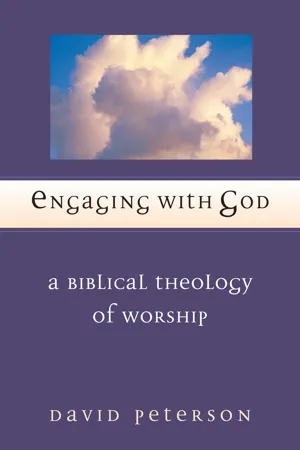
- English
- ePUB (mobile friendly)
- Available on iOS & Android
About this book
Worship is of immense concern in the church and ironically the source of controversy and dispute. Can we get behind the question of what style of worship we should engage in to understand the bedrock foundation for God's people--honoring him as he desires? Is the dissatisfaction with worship voiced by so many perhaps a result of our having wandered from biblical teaching on the subject?Through careful exegesis in both Old and New Testaments, David Peterson unveils the total life-orientation of worship that is found in Scripture. Rather than determining for ourselves how we should worship, we, his people, are called to engage with God on the terms he proposes and in the way he alone makes possible.This book calls for a radical rethinking of the meaning and practice of worship, especially by those responsible for leading congregations. Here is the starting place for recovering the richness of biblical worship.
Frequently asked questions
- Essential is ideal for learners and professionals who enjoy exploring a wide range of subjects. Access the Essential Library with 800,000+ trusted titles and best-sellers across business, personal growth, and the humanities. Includes unlimited reading time and Standard Read Aloud voice.
- Complete: Perfect for advanced learners and researchers needing full, unrestricted access. Unlock 1.4M+ books across hundreds of subjects, including academic and specialized titles. The Complete Plan also includes advanced features like Premium Read Aloud and Research Assistant.
Please note we cannot support devices running on iOS 13 and Android 7 or earlier. Learn more about using the app.
Information
Chapter one
Engaging with God in the
Old Testament
Worship and revelation
Holy places in the ancient world
The covenant-making God of Israel
Worship and redemption
Mount Sinai and the faith of Israel
The giving of the words of God
Table of contents
- Cover
- Title Page
- Contents
- Foreword
- Abbreviations
- Introduction
- 1. Engaging with God in the Old Testament
- 2. Honouring, serving and respecting God
- 3. Jesus and the new temple
- 4. Jesus and the new covenant
- 5. Temple and community in the Acts of the Apostles
- 6. Paul and the service of the gospel
- 7. Serving God in the assembly of his people
- 8. The book of Hebrews and the worship of Jesus
- 9. Worship in the Revelation to John
- 10. Worship and the gospel – a summary
- Epilogue
- Notes
- Index of Scripture references
- Index of subjects
- Index of modern authors
- Praise for Engaging with God
- About the Author
- More Titles from InterVarsity Press
- Copyright Page